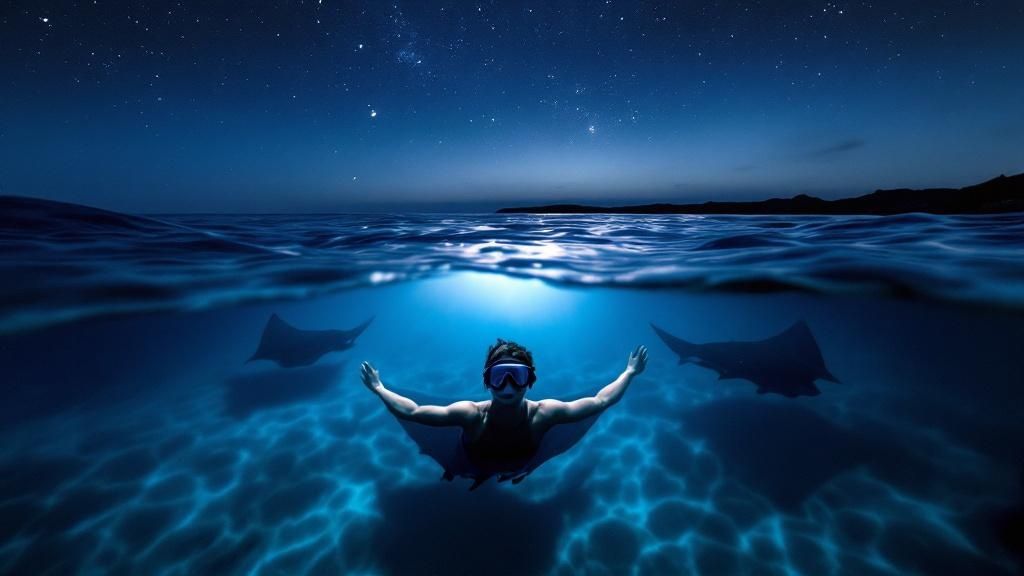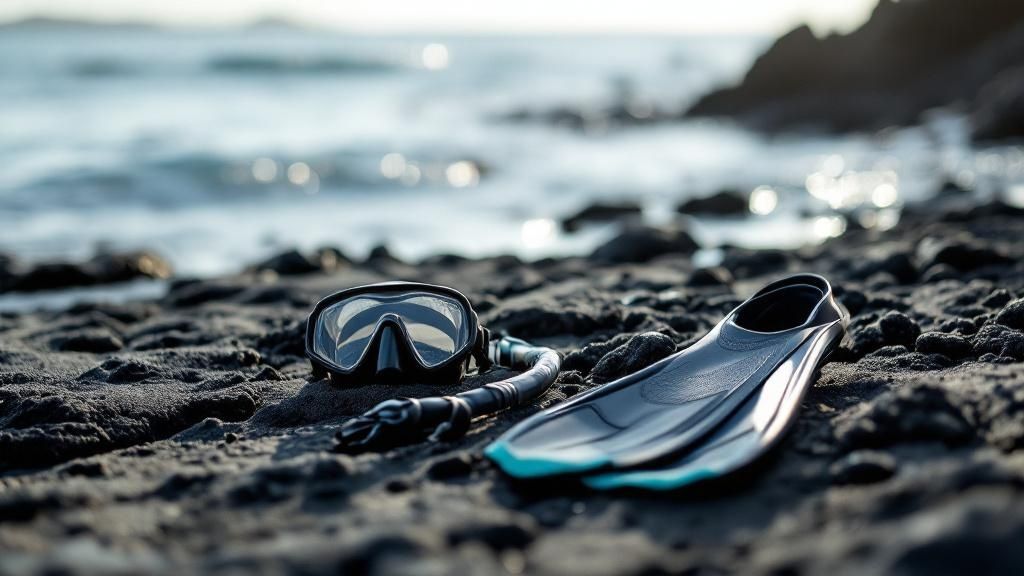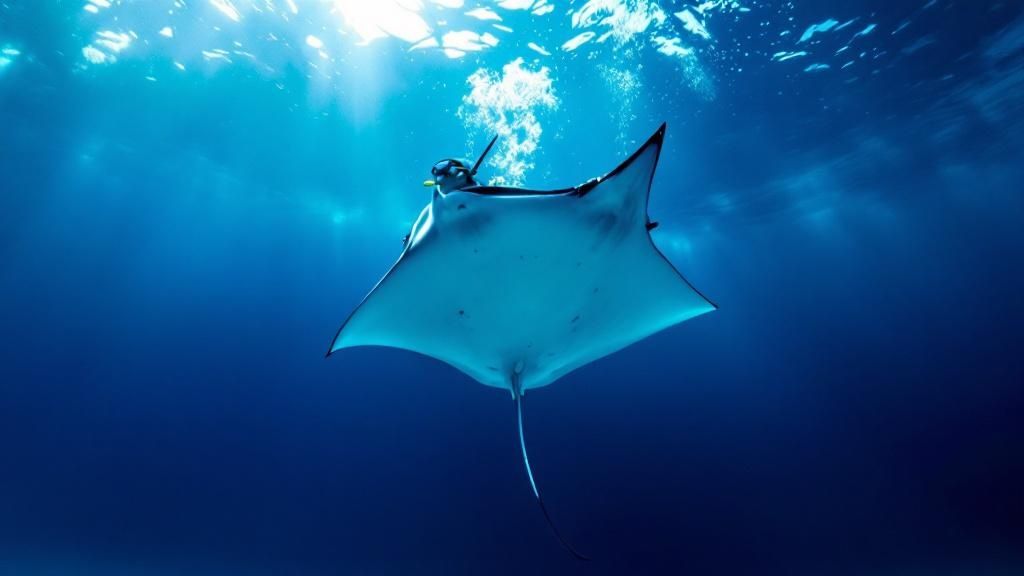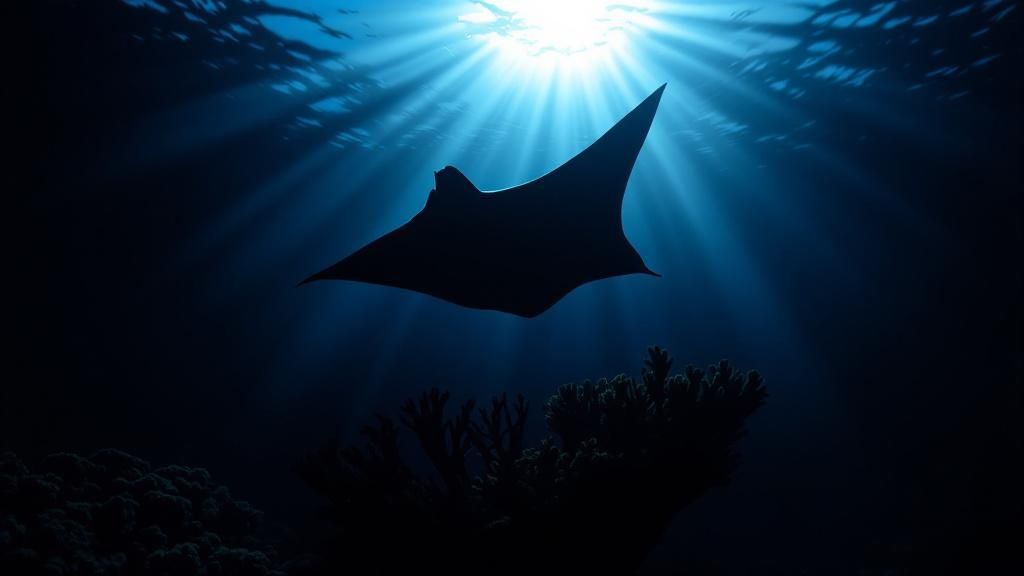Manta Ray Snorkel Kona: Your Complete Adventure Guide
- Byron
- May 30
- 11 min read
Why Kona Is Your Gateway To The World's Best Manta Ray Adventures
Kona, Hawaii, is renowned for its breathtaking beauty, but it's also a world-class destination for manta ray encounters. Why do 80,000 travelers flock to this Hawaiian town every year for underwater adventures? It's the unique combination of ideal conditions and thriving manta ray populations, a rare find anywhere else. Manta ray snorkeling in Kona is a globally recognized wildlife experience. This high volume speaks to its unique appeal and underscores the importance of manta ray encounters for the region's economy and tourism. Find more detailed statistics here Kona truly sets the gold standard for manta ray experiences, attracting enthusiasts worldwide.
The Perfect Habitat: A Convergence Of Factors
Several factors contribute to Kona's flourishing manta ray population. The volcanic formations along the Kona Coast create shelter and essential cleaning stations. Nutrient-rich ocean currents support an abundance of plankton, the manta ray's primary food source. This reliable food supply is a major reason why manta ray sightings in Kona are so consistent.
Guaranteed Encounters: Kona's Remarkable Success Rate
Kona has an astonishing 80-90% success rate for manta ray sightings. This consistency stems from the abundant food supply and unique underwater topography. Specific locations, like Manta Village, act as natural funnels, concentrating plankton at the surface and attracting manta rays for easy viewing. This predictability is a big part of Kona's popularity for manta ray snorkeling adventures.
To better understand Kona's standing as a premier manta ray destination, let's compare it to other popular locations around the world:
Kona Manta Ray Statistics vs Other Global Destinations
Comparison of sighting rates, annual visitors, and experience quality across major manta ray destinations worldwide
Destination | Annual Visitors | Sighting Success Rate | Best Season | Experience Type |
|---|---|---|---|---|
Kona, Hawaii | 80,000 | 80-90% | Year-round | Night Snorkeling |
Maldives | 500,000 (estimated) | 70-80% | May-November | Diving & Snorkeling |
Yap, Micronesia | 5,000 (estimated) | 60-70% | November-May | Diving |
Socorro Island, Mexico | 2,000 (estimated) | 50-60% | November-May | Diving |
Ningaloo Reef, Australia | 200,000 (estimated) | Varies depending on season | March-July | Snorkeling & Diving |
As this table demonstrates, Kona offers a remarkably high sighting success rate, particularly for night snorkeling. While other destinations may have higher overall visitor numbers, Kona's specialized focus on manta ray encounters gives it a distinct advantage.
Nighttime Magic: The Plankton-Light Connection
The nighttime manta ray snorkel experience in Kona is truly special. Tour operators use underwater lights that attract plankton, creating a feeding frenzy that brings the mantas close. Witnessing these graceful giants, their white bellies illuminated against the dark water, performing acrobatic feats while they eat is an unforgettable experience.
A Sustainable Approach: Conservation Through Tourism
Beyond the thrill of the encounter, participating in a manta ray snorkel tour in Kona supports important conservation efforts. The thriving tourism industry funds research programs that monitor individual manta rays, track their movements, and study their behavior. This data helps researchers and conservationists understand and protect these magnificent creatures. By choosing Kona, you’re contributing to a sustainable ecosystem that benefits both wildlife and the local community.
The Secret Science Behind Kona's Incredible Success Rates
The magic of almost guaranteed manta ray sightings in Kona isn't just luck. It's a delicate interplay between nature and human ingenuity. Underwater lighting systems, strategically placed at specific sites by local resorts and tour operators, play a key role. These lights attract plankton, the microscopic organisms that form the base of the manta ray diet. This deliberate plankton attraction is the foundation of Kona's remarkable success.
The Plankton-Light-Manta Ray Connection
Plankton are naturally drawn to light sources. This inherent behavior is cleverly used in Kona's manta ray viewing practices. The underwater lights mimic this natural phenomenon, creating concentrated areas of plankton. For example, at the two main snorkel sites—Manta Village (Garden Eel Cove) and Manta Heaven (Keauhou Bay)—resorts shine lights into the water, attracting plankton, which in turn draws manta rays every night.
These sites have average depths of 30–40 feet (Manta Village) and 20–50 feet (Manta Heaven), making them accessible to most snorkelers. This reliable food source makes these sites regular feeding grounds for manta rays, leading to consistently high sighting rates.

Kona's Unique Oceanographic Conditions
Kona's specific oceanographic conditions further enhance its success. The volcanic slopes of the Big Island create nutrient-rich upwellings that promote plankton growth. These slopes also act as natural funnels, concentrating plankton in certain areas, creating ideal viewing spots. The generally calm and clear waters of Kona provide excellent visibility, improving the chance for unforgettable encounters.
Supporting Thriving Manta Ray Populations
This carefully managed ecosystem supports thriving manta ray populations. The combination of plentiful food and suitable habitat creates ideal conditions. Kona boasts a remarkable 80-90% success rate for manta ray sightings. This high success rate benefits tourism and allows researchers to study and monitor these animals, contributing to their long-term protection.
Interested in the best time to visit? Check out this guide: How to master timing your visit. Ongoing research and conservation efforts, funded in part by tourism, ensure future generations can also experience the magic of Kona's manta rays. It's this scientific approach, combined with respect for the natural environment, that truly sets Kona apart.
Planning Your Perfect Manta Ray Adventure Strategy
Turning your manta ray dreams into reality starts with a solid plan. This involves figuring out the ideal time to visit Kona for the best manta ray sightings, and understanding how weather might affect your snorkeling trip. This proactive approach is what separates a good experience from a truly memorable one.
Timing Your Kona Visit for Maximum Manta Magic
Manta rays can be found in Kona's waters all year round, but certain times offer more predictable viewing opportunities. The months from April to October typically have calmer seas and better visibility. This makes for a more pleasant snorkeling experience, especially for those new to snorkeling. This period also coincides with Kona's dry season, meaning less chance of rain disrupting your adventure. Even during peak season, however, a backup plan for unexpected weather is essential.
Choosing the Right Tour Operator
Picking the right tour operator is crucial for a successful manta ray snorkel. Look for operators with established safety records and a commitment to sustainable practices. Experienced operators know about manta ray behavior and the top viewing spots. They also supply quality equipment and offer thorough safety briefings. These factors can significantly enhance your overall experience. You might find this helpful: How to master planning your Kona manta ray snorkel.
Essential Preparations for Your Adventure
Careful preparation ensures a smooth and enjoyable manta ray encounter. Consider these key points before heading out:
Physical Readiness: A comfort level in the water is important. Practice snorkeling beforehand if necessary.
Equipment: Most operators provide snorkeling gear, but bringing your own mask and snorkel can increase comfort and hygiene. An underwater camera is highly recommended to capture the magic.
Seasickness: If you're prone to seasickness, consider taking preventative measures before your tour.
Booking Strategy: Booking your tour ahead of time, particularly during the busy season, is highly recommended. This guarantees your spot and can sometimes offer early bird discounts.
Timing Considerations for Multiple Encounters
If you’re hoping for multiple manta ray encounters, scheduling tours on different nights boosts your chances of truly remarkable experiences. Consider visiting both Manta Village and Manta Heaven. Each location has unique qualities and varying depths, potentially giving you different perspectives of these amazing creatures. By following these planning strategies, you’ll be well-prepared for an unforgettable Kona manta ray adventure.
Choosing Tour Operators Who Deliver Exceptional Experiences
Not all manta ray tours are created equal. The operator you select can significantly impact your Kona manta ray snorkel adventure. Let's explore how to find companies that consistently deliver exciting encounters while prioritizing responsible interactions with these gentle giants. Choosing wisely is the key to a truly rewarding experience.
Key Factors That Separate the Best From the Rest
Several factors set exceptional manta ray tour operators apart. These include a strong commitment to safety, high-quality equipment, and a genuine dedication to marine conservation. For instance, operators with smaller groups often provide more personalized attention and minimize disruption to the manta rays’ natural environment. Knowledgeable guides with experience in manta ray behavior and the local ecosystem can also greatly enhance your trip.
Safety Protocols: Look for operators with lifeguard-certified guides and well-defined safety procedures.
Equipment Quality: Make sure the snorkeling gear provided is in good condition and fits you correctly. A comfortable, properly fitting wetsuit is especially important for nighttime tours.
Marine Conservation: Choose tour operators who emphasize sustainable tourism, such as following strict viewing guidelines and actively supporting local conservation projects.
Understanding Tour Formats and Pricing
Manta ray snorkel tours in Kona offer a variety of formats, each with a different pricing structure. Knowing these differences will help you select the best tour for your needs and budget.
Shared Tours: This is the most common and typically most affordable option. Shared tours are great for solo travelers, couples, and families.
Private Charters: Private charters provide a more customized experience for smaller groups, with increased flexibility and individual attention from the guide.
Combined Tours: Some operators combine manta ray snorkeling with other activities, such as exploring Captain Cook Bay. These combination tours offer a wider view of Kona's marine life.
When comparing prices, be sure you know what is included. Some tours cover wetsuit rentals, underwater photography, or snacks and drinks, while others may have additional charges for these items.
Insider Knowledge for Enhanced Adventures
A few helpful tips can significantly enhance your manta ray snorkel experience:
Booking Timing: Booking ahead of time, especially during the popular season (April to October), is highly recommended. This guarantees your spot and may even get you an early booking discount.
Special Considerations: If you're prone to seasickness, consider taking precautions before the tour or opting for a larger, more stable boat. Let your guide know about any concerns you have about swimming at night or general comfort in the water. They can offer reassurance and support.
Supporting Sustainable Tourism: Seek out operators involved in research and conservation programs. By choosing these operators, you directly contribute to protecting these amazing creatures.
By considering these factors, comparing pricing structures, and using these insider tips, you can choose a manta ray tour operator in Kona that will provide an exceptional and responsible underwater experience. Careful planning will not only enhance your personal adventure but also support responsible tourism, ensuring the preservation of Kona’s manta rays for generations to come.

What Actually Happens During Your Underwater Encounter

Stepping into the waters off Kona for a manta ray snorkel is truly an unforgettable experience. It’s like entering a different world. Understanding what happens during this magical encounter can make it even more special. This guide will walk you through a typical manta ray snorkel session in Kona, from the moment you enter the water to when you return to the boat. We'll also cover the important protocols that keep both you and the manta rays safe. For more tips, check out this helpful guide: How to Master a Manta Ray Snorkel Kona Experience.
Entering the Underwater World: Lights, Plankton, and Manta Rays
Once you're in the water, you'll hold onto a flotation device equipped with lights. These lights attract plankton, the main food source for manta rays. The lights create a “manta ray ballet” as the mantas gracefully glide through the water, feeding on the illuminated plankton. With the average Kona manta ray reaching 10-12 feet wide, it's a breathtaking sight.
Manta Ray Feeding Behavior: A Barrel Roll Feast
As the plankton gathers, get ready to witness the manta rays’ fascinating feeding behaviors. You'll likely see barrel rolls, acrobatic flips the mantas perform to eat as much plankton as possible. They might also engage in chain feeding, where multiple mantas line up to filter the plankton, creating a mesmerizing spectacle. The close proximity provides incredible views of their unique markings and elegant movements.
Snorkeling Etiquette: Respecting the Gentle Giants
Respectful interaction with the manta rays is key. Your guide will explain the best practices for snorkeling with these gentle giants. These typically include keeping a respectful distance and not touching the mantas. This protects their sensitive skin and minimizes disruption to their natural feeding habits. Even with these precautions, the manta rays often swim incredibly close, offering a truly personal encounter.
Site-Specific Insights and Group Dynamics
Kona has several manta ray snorkel sites, each with distinct characteristics. Manta Village and Manta Heaven are two popular locations, each with different depths and bottom compositions. Tour groups are generally small, around 10-20 people, to minimize disturbance to the manta rays. This smaller group size also creates a more intimate experience. Your guide will share information about each site, enhancing your understanding of this incredible ecosystem. This is a truly unique way to connect with these gentle giants and their underwater world.
Supporting Conservation Through Responsible Tourism
Behind every magical manta ray snorkel Kona experience is a powerful conservation story. By choosing a manta ray snorkel tour, you're directly supporting research and protection efforts for these gentle giants. This sustainable approach helps ensure future generations can also witness these graceful creatures.
Monitoring Programs and Identification Systems
Researchers use comprehensive monitoring programs to track individual manta rays. These programs rely on sophisticated identification systems, similar to fingerprint recognition. Each manta ray has unique spot patterns on its underside, allowing researchers to identify and catalog them. This tracking helps scientists understand their complex behavior, migration patterns, and population dynamics.
Manta Ray Advocates, a local advocacy group, has systematically recorded manta ray sightings along the Kona Coast since 2009. Manta Ray Advocates provides valuable insights into individual manta behavior and movement. Some rays have been tracked covering remarkable distances, like 42 miles in just 8 days. This long-term data collection is essential for understanding population trends and the overall health of the manta ray population. Discover more insights about manta ray statistics.

How Tourism Funds Conservation
Responsible tourism plays a key role in funding these important conservation efforts. Proceeds from manta ray snorkel Kona tours directly support ongoing research projects and the maintenance of identification databases. This funding allows scientists to monitor population health, study manta ray behavior, and develop effective conservation strategies.
The Economic Impact of Sustainable Tourism
The economic benefits of sustainable tourism also create strong reasons for local communities to protect manta rays. The thriving manta ray tourism industry provides jobs and income for local businesses, making manta ray protection a shared goal. This connection between tourism and conservation ensures that the well-being of manta rays and the economic health of the community are linked. By choosing a manta ray snorkel tour, you're not just having an amazing experience, you’re contributing to a larger conservation effort.
Maximizing Every Moment Of Your Manta Ray Experience
Transform your manta ray snorkel Kona adventure from memorable to truly extraordinary. Planning ahead and knowing a few insider tips can greatly enhance this special experience. This guide covers everything from what to pack and how to prepare to suggestions for post-snorkel activities that will complement your Kona manta ray experience.
Preparing For Your Underwater Encounter
Before you even get to the water, a little preparation can make a world of difference. Packing the right gear ensures comfort and helps you get the most out of your time in the water. While Kona’s waters are generally warm, a 3mm wetsuit adds extra warmth, especially for night swims. You might even prefer a 5mm wetsuit in the winter months. Don't forget water shoes for the boat deck and rocky entry points. A good quality underwater camera, like a GoPro, with low-light capability is essential for capturing those manta ray moments. Make sure to test it thoroughly before you go to avoid any technical glitches.
Essential Checklist for an Unforgettable Experience
To ensure you're completely prepared, take a look at this helpful checklist before your manta ray snorkel Kona adventure.
Category | Essential Items | Recommended | Notes |
|---|---|---|---|
Gear | Wetsuit (3mm or 5mm), Water Shoes, Underwater Camera | Snorkel, Mask, Fins (often provided by tour operators) | Ensure your camera has low-light capabilities and is fully charged. |
Personal Items | Towel, Dry Clothes | Seasickness medication (if needed), Reef-safe sunscreen | Apply sunscreen before you arrive at the dock to allow it to absorb. |
Booking & Logistics | Confirmed tour reservation | Book in advance, especially during peak season | Consider transportation options to and from the dock. |
Safety | Listen to your guide's instructions, Stay with the group | Familiarize yourself with basic snorkel safety guidelines | Be aware of ocean conditions and your own swimming abilities. |
This checklist covers everything from equipment and personal items to booking confirmations and essential safety reminders. Being prepared allows you to relax and enjoy the experience to the fullest.
Beyond The Snorkel: Extending Your Kona Adventure
Your manta ray snorkel Kona experience can be the highlight of a larger Big Island adventure. Kona has plenty to offer beyond the water. Think about exploring nearby beaches, hiking volcanic trails, or visiting local coffee plantations to see the diverse landscapes of the island. For instance, Captain Cook Bay combines historical exploration with fantastic snorkeling opportunities. By combining your manta ray snorkel with other activities, you can make the most of your time and budget. This creates a well-rounded Hawaiian vacation truly showcasing the wonders of nature.
Photography Tips for Capturing The Magic
To truly capture the magic of your manta ray snorkel Kona experience, remember these photography tips. Adjust your camera settings for low-light conditions. It's a good idea to experiment with ISO levels and shutter speeds before your trip. A red filter can enhance colors and compensate for the loss of red light underwater. Most importantly, be patient and watch closely. Manta rays are graceful, but their movements can be unpredictable. Understanding their behavior will help you anticipate photo opportunities and get some stunning pictures of these gentle giants.
Ready for an unforgettable manta ray adventure? Book your tour today with Manta Ray Night Snorkel Hawaii and experience the magic! Book Your Manta Ray Snorkel Adventure Now!
Comments